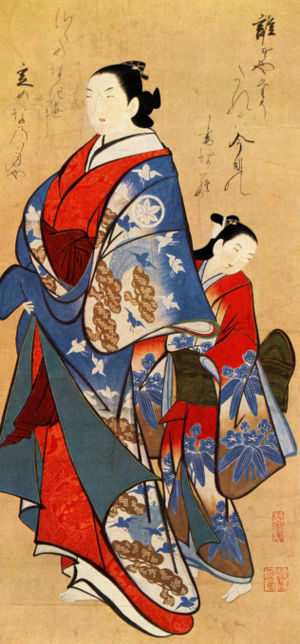
Kaigetsudo school
Encyclopedia

Ukiyo-e
' is a genre of Japanese woodblock prints and paintings produced between the 17th and the 20th centuries, featuring motifs of landscapes, tales from history, the theatre, and pleasure quarters...
painting and printmaking founded in Edo
Edo
, also romanized as Yedo or Yeddo, is the former name of the Japanese capital Tokyo, and was the seat of power for the Tokugawa shogunate which ruled Japan from 1603 to 1868...
around 1700-1714. It is often said that the various Kaigetsudō artists' styles are so similar, many scholars find it nearly impossible to differentiate them; thus, many Kaigetsudō paintings are attributed to the school's founder, Kaigetsudō Ando
Kaigetsudo Ando
Kaigetsudō Ando , also known as Ando Yasunori, was a Japanese painter, and the founder of the Kaigetsudō school of ukiyo-e. Though very influential and prolific, it is quite probable that many of the works attributed to him were actually painted by his disciples...
, which may have been in fact painted by his disciples.
The school's founder, Ando Yasunori, known by his art-name
Art-name
An art-name is a pseudonym, or penname, used by an East Asian artist, which they sometimes change. The word and the idea to use a pseudonym originated from China, then became popular in other East Asian countries ....
(gō) Kaigetsudō Ando, was a specialist in bijinga
Bijinga
Bijinga , is a generic term for pictures of beautiful women in Japanese art, especially in woodblock printing of the ukiyo-e genre, which predate photography...
, images of beautiful women. Unlike his disciples, Ando produced only paintings, never prints. His style, and that of the school, draws strongly upon the style of the Torii school
Torii school
This article is about a school of ukiyo-e art; for the sculpture style, see Tori style. For the Torii samurai clan, see Torii family.The Torii school was a school of ukiyo-e painting and printing founded in Edo...
, which is known primarily for its theater signboards. The style of both schools is distinguished by its use of thick lines and bright colors. However, the Kaigetsudō style is said to depict subjects in a very stereotyped manner, which is in sharp contrast to the style of the Torii school.
The Kaigetsudō artists are known primarily for their prints of bijin with very colorful and complex patterns on their kimono. While these images may be seen as displaying fashion designs, it is far more likely that the artists' intended to focus on the beauty and grace of the women themselves. The printmakers sought to share the fame and magnificence of the women of the Yoshiwara
Yoshiwara
Yoshiwara was a famous Akasen district in Edo, present-day Tōkyō, Japan.In the early 17th century, there was widespread male and female prostitution throughout the cities of Kyoto, Edo, and Osaka. To counter this, an order of Tokugawa Hidetada of the Tokugawa shogunate restricted prostitution to...
with those unable to afford to experience the ukiyo (Floating World) in person.
While the school of course produced many unique works, many were based on reproducing very similar poses or images, with only the colors or kimono pattern changed.
Though a handful of artists took on the Kaigetsudō name for themselves, and sought to imitate the style, the work of Kaigetsudō Ando's direct disciples fell into sharp decline after his banishment to Ōshima
Izu Oshima
is a volcanic island in the Izu Islands and administered by the Tokyo Metropolitan government, Japan, lies about 100 km south of Tokyo, 22 km east of the Izu Peninsula and 36 km southwest of Bōsō Peninsula. serves as the local government of the island...
in 1714.
Significant artists of the Kaigetsudō school
- Kaigetsudō AndoKaigetsudo AndoKaigetsudō Ando , also known as Ando Yasunori, was a Japanese painter, and the founder of the Kaigetsudō school of ukiyo-e. Though very influential and prolific, it is quite probable that many of the works attributed to him were actually painted by his disciples...
- founder of the school - Kaigetsudō AnchiKaigetsudo AnchiKaigetsudō Anchi was a Japanese painter and printmaker of the Kaigetsudō school of ukiyo-e art. He was the student, and likely the son of the school's founder, Kaigetsudō Ando....
- Kaigetsudō Dohan
- Kaigetsudō Doshin
- Kaigetsudō Doshu
- Kaigetsudō Doshū
- Matsuno ChikanobuMatsuno ChikanobuMatsuno Chikanobu was a Japanese painter of the Kaigetsudō school of ukiyo-e. Believed to be one of the most popular painters of his time, his work, very much in the Kaigetsudō style, consists largely of bijinga and features bright colors and exquisite kimono fashions.He is believed to have...
- Tōsendō Rifū
- Takizawa Shigenobu
- Baiyūken Katsunobu
- Baiōken Nagaharu
- Takeda HarunobuBaioken Eishunwas a Japanese painter and print artist of the Kaigetsudō school of ukiyo-e art. He is also alternatively known as , Baiōken Nagaharu, Takeda Harunobu and a number of other art-names...

